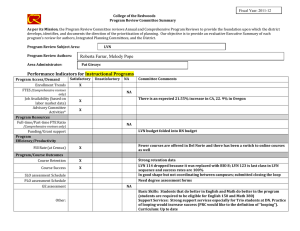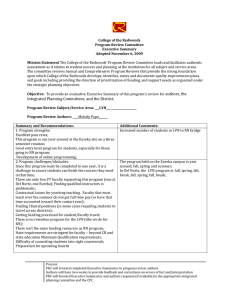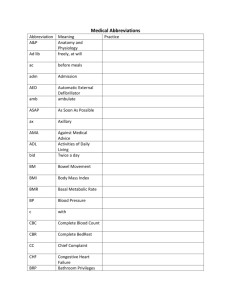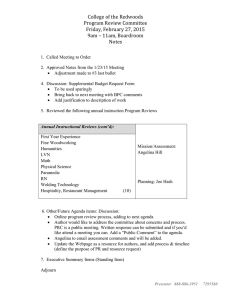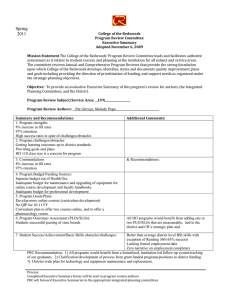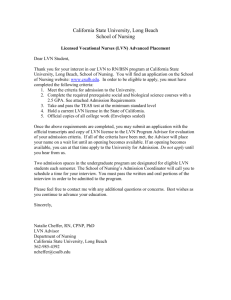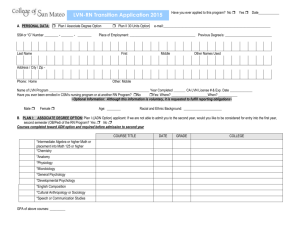Instructional Program Review Template for Academic Year 2013‐2014
advertisement
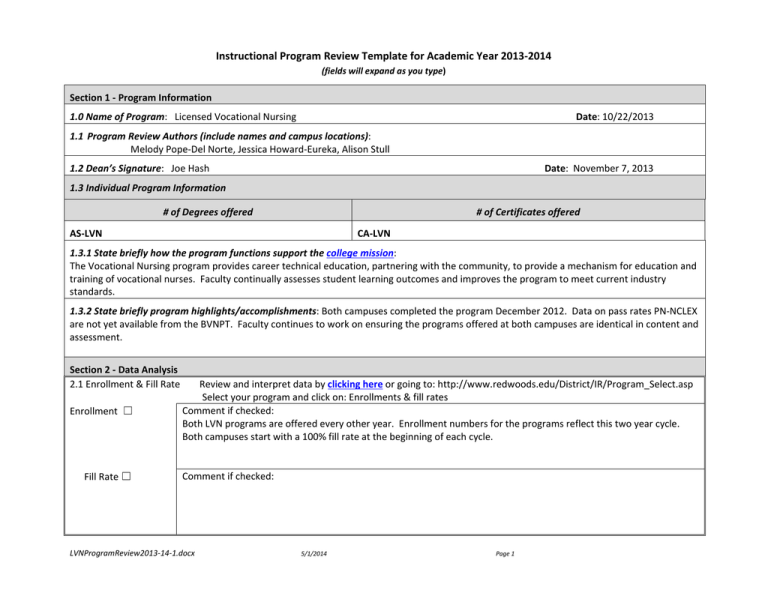
Instructional Program Review Template for Academic Year 2013‐2014 (fields will expand as you type) Section 1 ‐ Program Information 1.0 Name of Program: Licensed Vocational Nursing Date: 10/22/2013 1.1 Program Review Authors (include names and campus locations): Melody Pope‐Del Norte, Jessica Howard‐Eureka, Alison Stull 1.2 Dean’s Signature: Joe Hash Date: November 7, 2013 1.3 Individual Program Information # of Degrees offered # of Certificates offered AS‐LVN CA‐LVN 1.3.1 State briefly how the program functions support the college mission: The Vocational Nursing program provides career technical education, partnering with the community, to provide a mechanism for education and training of vocational nurses. Faculty continually assesses student learning outcomes and improves the program to meet current industry standards. 1.3.2 State briefly program highlights/accomplishments: Both campuses completed the program December 2012. Data on pass rates PN‐NCLEX are not yet available from the BVNPT. Faculty continues to work on ensuring the programs offered at both campuses are identical in content and assessment. Section 2 ‐ Data Analysis 2.1 Enrollment & Fill Rate Review and interpret data by clicking here or going to: http://www.redwoods.edu/District/IR/Program_Select.asp Select your program and click on: Enrollments & fill rates Comment if checked: Enrollment ☐ Both LVN programs are offered every other year. Enrollment numbers for the programs reflect this two year cycle. Both campuses start with a 100% fill rate at the beginning of each cycle. Comment if checked: Fill Rate ☐ LVNProgramReview2013‐14‐1.docx 5/1/2014 Page 1 2.2 Program Majors Review and interpret data by clicking here or going to: http://www.redwoods.edu/District/IR/Program_Select.asp Select your program and click on: Enrollments & fill rates Comment if checked: Enrollment ☐ Enrollment is limited by the lottery system. Each campus can only admit 30 students to the program every other year. The data shows throughout the district a total of 145 students declared the LVN program as a major. These students may be working on co‐requisites while they are on the wait list for the program. Comment if checked: Fill Rate ☐ Both campuses have a 100% fill rate every other year. 2.3 Success & Retention Review and interpret data by clicking here or going to: http://www.redwoods.edu/District/IR/Program_Select.asp Select your program and click on: Success & Retention Success ☐ Comment if checked: The program success rate is well above the District average of 69 % with both programs success rate at 97%. Retention ☐ Comment if checked: Retention for both programs for 2012‐2013 was 100%. 2.4 Persistence of Concentrators Review and interpret data by clicking here or going to: http://www.redwoods.edu/District/IR/Program_Select.asp Select your program and click on: Persistence of Concentrators ☐ Comment: In both Eureka and Del Norte there are 30 students who enter the program every other year with a competition rate between 60‐95%. As with the ADN program, the student’s interest when entering the College needs to be differentiated from the students who actually enter the LVN program, complete the program and achieve licensure. Data needs to be refined to more accurately reflect data reports from external accrediting agencies. 2.5 Program Completers Review and interpret data by clicking here or going to: http://www.redwoods.edu/District/IR/Program_Select.asp Select your program and click on: Completions & Transfers ☐ Comment: A total of 35 certificates were awarded and of those 35 students 17 earned an Associate’s Degree. This data consistent with State and National completion rates for similar programs. Student Equity Group Data LVNProgramReview2013‐14‐1.docx 5/1/2014 Page 2 2.5 Enrollments Review and interpret data by clicking here or going to: http://www.redwoods.edu/District/IR/Program_Select.asp by group Select your program and click on ~ by Student Equity Group next to Enrollments & fill rates Comment: Enrollments by equity group closely reflect the District percentages with the following exception: they tend to be older, and female. The programs have higher retention rates for DSPS students and basic skills. There is a higher enrollment rate of American Indians on both campuses. 2.6 Success & Retention Review and interpret data by clicking here or going to: http://www.redwoods.edu/District/IR/Program_Select.asp by group Select your program and click on ~ by Student Equity Group next to success & retention Comment: The overall success and retention by equity group is higher than the District percentages. 2.7 Completers Review and interpret data by clicking here or going to: http://www.redwoods.edu/District/IR/Program_Select.asp by group Select your program and click on ~ by Student Equity Group next to persistence Comment: Actual numbers of students enrolled in the LVN programs is not reflected accurately in the data set as number of students who declared interest in the program is far higher than the number of students accepted into the program bi‐ annually. This data set needs to be revised to address this issue. 2.8 Faculty Information Review and interpret data by clicking here or going to: http://www.redwoods.edu/District/IR/Program_Select.asp Select your program and click on: Faculty (FT/PT) & FTES/FTEF Comment: The LVN Program consists of lecture and clinical lab courses. The three semesters of the program requires 176.25 TLUs for staffing for each location (Del Norte and Eureka). Each program is required to have 1 FT faculty. Each teaches 67.5 TLUs over 3 semesters with the additional 108.75 taught by AF who must be approved by the state’s BVNPT. A new FT faculty was hired for the Eureka program 10/2013. The FT from IR show 4 FT faculty where there were only 2 FT faculty in 2012‐2013. We are working with admissions and records staff and IR to correct the data entry in order to reflect true numbers. CTE/Occupational programs The following Labor Market section should be completed by all CTE/Occupational programs. Only CTE/Occupational programs need to complete this section (2.9). 2.9 Labor Market Data Refer to the California Employment Development Division: http://www.edd.ca.gov/ www.labormarketinfo.edd.ca.gov Provide a narrative that addresses the following: a. Documentation of labor market demand b. Non‐duplication of other training programs in the region c. Effectiveness as measured by student employment and program completions. LVNProgramReview2013‐14‐1.docx 5/1/2014 Page 3 Narrative: By 2018, there is an expected 21.5% increase in the demand for LVNs in California. The LVN license is a transferable license and some of the graduates of the Del Norte campus live in and return to work in the Oregon area. According to the Oregon Board of Nursing, 43% of their Licensed Practical Nurses (LPN/LVN) come to them through license transfer. The state of Oregon expects a 22.9% increase in demand for LPNs by 2018. There are no other local training programs for LVNs in Humboldt or Del Norte counties. There is no LPN training program at the closest Oregon community college‐Southwestern Oregon Community College. The closest programs in California are at College of the Siskiyous, Mendicino College, and Redding’s Institute of Technology. Graduate from the LVN programs at CR are employed at local long term care facilities, the local hospitals, and Pelican Bay State Penitentiary. Data from the December 2012 graduating class is not yet available. Summary of Section 2 Overall, what did you learn from the data provided in this section? Be sure to indicate if your discoveries apply to the entire district, or if they vary by site. Because the data are skewed it is not possible to reflect on what the data represents which makes it difficult to interpret in any meaningful way. Section 3 – Critical Reflection of Assessment Activities Curriculum & Assessment Data What courses, if any are not on track with regard to a 2‐year assessment cycle? Explain if this is a consequence of how often the course is offered or other mitigating factors such as outcome updates that may have changed the assessment cycle. # of course SLO reports submitted during 2012‐2013. Reports submitted in 2012‐13 up to the Sept 15, 2013 deadline were included in 2012‐2013. # of degree/cert (PLO) reports submitted during 2012‐2013. Reports submitted in 2012‐13 up to the Sept 15, 2013 deadline were included in 2012‐2013. % of Course Outlines of Record updated If there is no plan for updating outdated curriculum, when will you inactivate? View curriculum status: click here or go to: http://www.redwoods.edu/District/IR/Program_Select.asp Select your program and click on: Curriculum Status Did the Program Advisory Committee Met? No LVNProgramReview2013‐14‐1.docx 5/1/2014 Page 4 N/A 7 1 LVN 114 will be inactivated, and LVN 110A, 110B and 111 are being updated and will be through Curriculum by December 2013. 3.0 How has assessment of course level SLO’s led to improvement in student learning (list the top three): 1. Consistency in program offerings make student more prepared for transition into the job market. 2. Focus on QSEN has improved critical think skills and safety awareness in this student population. 3. Consistent assessment tools allow students to find more meaning in the assessment process. 3.1 How has assessment of degree/cert (program) level outcomes led to degree/certificate improvement (list the top three): National pass rates were 88% and California pass rates 75%. The Eureka campus is 89% and Del Note 100% for the last review October 1, 2012‐ September 30, 2013. This is for the cohort graduating December 2012. Assessments have led to higher pass rates that are greater than both the National and State average. Those are job skills that transferable nationally. Using consistent assessment tools has increased the pass rates on the Del Norte campus to 100% consistently over several cohorts. See action plan for future plan for integration of consistent assessment tools across both campuses. 3.2 (Optional) Describe assessment findings/observations that may require further research or institutional support: Section – 4 Evaluation of Previous Plans 4.1 Describe plans/actions identified in the last program review and their current status. What measurable outcomes were achieved due to actions completed. Action plans may encompass several years; an update on the current status, or whether the plan was discarded and why. Actions Taken Current Status Impact of Action (describe all relevant data used to evaluate the impact) Faculty on both campuses are currently in the process of reviewing LVN 111 and integrating the theory content into LVN 110A and the skills/lab portion into LVN 121. Improved correlation between theory content Full time faculty at both campuses have met and are in the progress of updating the and skills acquisition. Curriculum for LVN 121, and LVN 110A to Decreased administrative/advisement support include the content of LVN 111. needed for enrolling students in a 0.5 unit lab. During the Self‐study for external These 0.5 units will be added to one of the accreditation for the BVNPT we will update other courses (LVN 110a or LVN 121). course content for approval. Inactivation of LVN 111 4.2 (If applicable) Describe how funds provided in support of the plan(s) contributed to program improvement: LVNProgramReview2013‐14‐1.docx 5/1/2014 Page 5 Section – 5 Planning Click here to link to Institutional Planning Documents 5.1 Program Plans Based on data analysis, student learning outcomes and program indicators, assessment and review, and your critical reflections, describe the actions to be taken for the 2013‐2014 academic year. Use as many rows as you have actions, and add additional rows if you have more than 5 actions. Please number all rows that you add. Please be specific. This section and section 6 should include a detailed justification so that the resource prioritization committees understand your needs and their importance. * Not all actions in this program plan section may require resources, but all resource requests must be linked to this section. 5.1 Program Plans Action # 1 Action to be taken: List the specific action to be taken in enough detail so that someone outside of your area can understand. Faculty from both programs will meet and complete the integration of LVN 111 into LVN 121 lab, and LVN 110A lecture. LVN 111 will be LVNProgramReview2013‐14‐1.docx Relationship to Institutional Plans Include the specific plan and action item relevant to your action For example: Annual Plan 2013‐2014 Theme: Persistence; or Goal 1: Student Success: EP.1.6.2 Develop a plan for narrowing the achievement gap for underrepresented student populations. Annual Plan 2013‐2014 Theme: Increasing Persistence EP.1.1 Provide structured academic pathways 5/1/2014 Expected Impact on Program/Student Learning Relationship to Assessment Describe the expected impact in a way that someone outside the program can understand. The impact should be measurable. Assessment revealed the lab provided in LVN 111 would be more easily assimilated if provided in sequence with the LVN 121 and LVN 110A lecture Include all assessment results that indicate that this action will yield the desired impact on the program. If the assessment has yet to be conducted, explain when and how it will be conducted. Improved correlations between theory content and skills acquisition. Decreased Page 6 Resources Needed (Y/N) A yes here requires a corresponding request in the next section. Yes 2 deactivated. and lab content. Annual Plan 2013‐2014 Theme: Increasing Persistence Goal 1: Student Success SP.1.2 Continuously assess Faculty will attend ATI and evaluate programs to training to learn to fully provide effective integrate ATI into the educational programs and curriculum and to accomplish services for all learners. goal of consistent assessment across the district. Integration of the skills and content into LVN 121 and LVN 110A will enhance student support and engagement by connecting concepts. Data shows that through consistent assessments using a system that is more closely mirroring the National Licensure exams that students have achieved a higher pass rates on the Del Norte campus. We would expect to see increased, consistent and sustained pass rates across the district. administrative/advisement support for enrolling students in the 0.5 unit lab. ATI is a standardized national program allows us to assess our students on a state and national program prior to their completion of the National Board Licensing Exam. Yes 5.2 Provide any additional information, brief definitions, descriptions, comments, or explanations, if necessary. LVNProgramReview2013‐14‐1.docx 5/1/2014 Page 7 Section 6 ‐ Resource Requests 6.0 Planning Related, Operational, and Personnel Resource Requests. Requests must be accompanied by an action plan in the above section. Requests should include estimated costs. If you are requesting personnel resources, you must also include the “Request for Faculty or Staffing” forms, located at inside.redwoods.edu/program review. Submit one form for each request. * The item number must match the corresponding action # from section 5. Add rows as necessary. Request Check One Amount Describe planning requests for the prioritization committees, operational requests for your Dean?, and Personnel use above Action# requests for …….. Planning Operational Personnel $ 1 Release time for Curriculum (3 TLU) X $6000.00 Replacement computers for AT 115 2 Computer lab (3 total computers) X $6,000.00 Equipment maintenance, installation (both 2 campuses) X $15,000.00 Section 7‐Author Feedback Provide any constructive feedback about how this template or datasets could be improved. The data needs to be appropriate and applicable to our program. How much do you agree with the following statements? Strongly Somewhat Somewhat Strongly Neutral Agree Agree Disagree Disagree This year’s program review was valuable in X planning for the ongoing improvement of my program. Analysis of the program review data was useful in assessing my program. X LVNProgramReview2013‐14‐1.docx 5/1/2014 Page 8 Recurring Cost Y/N N N Y Section 8‐ PRC Response by section (completed by PRC after reviewing the program review) 8.0 The response will be forwarded to the author and the supervising Director and Vice President: S.1. Program Information: Completed. S.2. Data Analysis: Acceptable. Working with A&R and IR to correct data entry to correct true numbers. High number of female students. No discussion on how remedy that. S.3. Critical Reflection of Assessment Activities: Acceptable. Only one program level report is listed for 2012-2013. This does not appear to be on track for completing a 2-cycle of assessing all PLOs. PRC recommends providing clear linkages between assessment results and improvements. The authors did state that assessments led to improvement, but the connections are not well documented within the program review report or assessment reports. S.4. Evaluation of Previous Plans: Acceptable. Combining things to better utilize resources S.5. Planning: Acceptable. FT faculty are integrating courses to improve content and skills acquisition, based on assessment based on a state and national program. Need to tie planning to resources and SP and EMP and Assessment. S.6. Resource Requests: D Section 5 planning noted resources needed that were not included in Section 6. LVNProgramReview2013‐14‐1.docx 5/1/2014 Page 9
